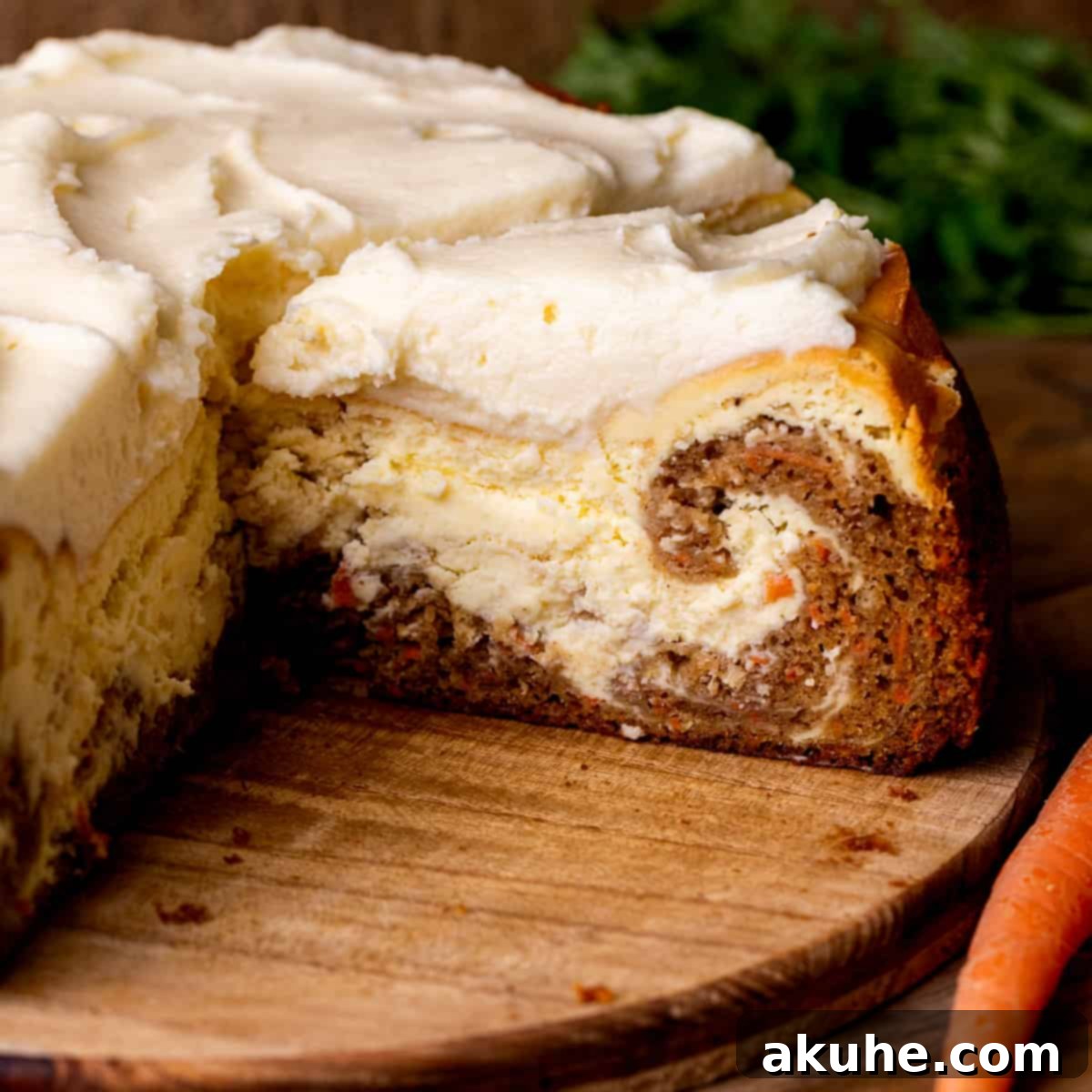Welcome to the ultimate dessert experience: the **Carrot Cake Cheesecake**. This extraordinary creation masterfully blends the rich, spiced notes of a classic carrot cake with the smooth, creamy indulgence of a New York-style cheesecake. It’s not just a cake; it’s a celebration of two beloved desserts, swirled together in perfect harmony and crowned with a luscious cream cheese frosting that melts in your mouth. If you’ve ever found yourself torn between these two delightful treats, your search ends here. This recipe delivers the best of both worlds in every single bite, offering a dessert that is both familiar and excitingly new.
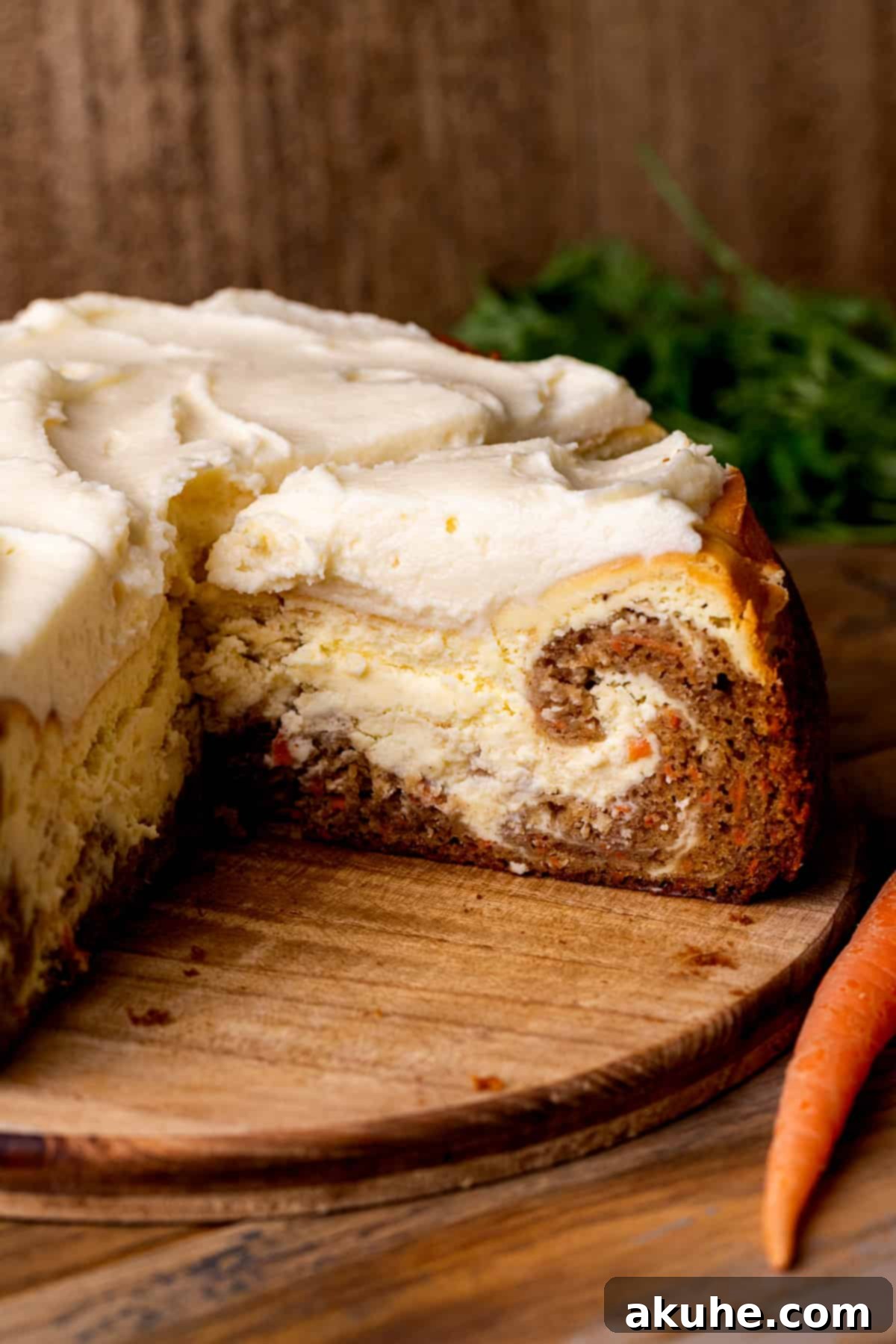
Imagine the warm, comforting spices of cinnamon, nutmeg, and ginger infused into a moist carrot cake, beautifully intertwined with a velvety, tangy cheesecake. Each forkful provides an exquisite contrast of textures and flavors – the tender crumb of the cake meeting the silky, decadent cheesecake, all brought together by the iconic sweet and tangy cream cheese frosting. This isn’t just a dessert; it’s a culinary journey designed to impress. Perfect for holidays, special occasions, or simply a luxurious weekend treat, this carrot cake cheesecake is guaranteed to become a new favorite in your recipe collection. Prepare to dazzle your taste buds and those of your guests with this truly unforgettable dessert.
Looking for more show-stopping cheesecake recipes to add to your repertoire? Explore some of our other delightful creations: Caramel Apple Cheesecake Bars offer a seasonal twist, while our Sugar Cookie Cheesecake provides a fun, festive option. For chocolate lovers, the Chocolate Cheesecake Brownie Bars are an absolute must-try.
Why This Carrot Cake Cheesecake Recipe Stands Out
This isn’t just another dessert recipe; it’s a carefully crafted culinary experience designed to deliver maximum flavor and enjoyment. Here’s why this particular carrot cake cheesecake recipe is a cut above the rest:
- Unforgettable Flavor Profile: This recipe harmonizes the robust, earthy sweetness of carrot cake with the bright, creamy tang of cheesecake. The carefully balanced spices in the carrot cake complement the rich dairy notes of the cheesecake, creating a symphony of flavors that is both comforting and sophisticated. It’s a perfect marriage of classic tastes, resulting in an exceptionally delicious dessert that satisfies every craving.
- Visually Stunning Marbled Layers: One of the most captivating aspects of this cheesecake is its beautiful marbled appearance. By artfully layering dollops of carrot cake batter and cheesecake batter, we achieve distinct yet interwoven patterns. This not only makes each slice a work of art but also ensures that you get a perfect blend of both carrot cake and cheesecake in every single bite. The visual appeal alone makes it a showstopper at any gathering.
- Exquisite Textural Harmony: The contrast in textures is a key element of this dessert’s appeal. The moist, tender crumb of the carrot cake provides a delightful counterpoint to the incredibly smooth and creamy texture of the cheesecake. This interplay prevents either component from feeling too heavy or monotonous, creating an eating experience that is rich, satisfying, and utterly irresistible. You’ll find yourself reaching for another slice just to enjoy that perfect textural balance.
- Ideal for Any Occasion: Whether you’re celebrating a birthday, hosting a holiday dinner, or simply treating yourself to something special, this carrot cake cheesecake fits the bill. Its impressive presentation and crowd-pleasing flavors make it suitable for grand celebrations, while its comforting essence makes it a wonderful indulgence for quiet evenings at home.
- Easier Than It Looks: While the final result appears complex, the step-by-step instructions are clear and easy to follow, making this recipe approachable for bakers of various skill levels. We guide you through each stage, ensuring a smooth and enjoyable baking process from start to finish.
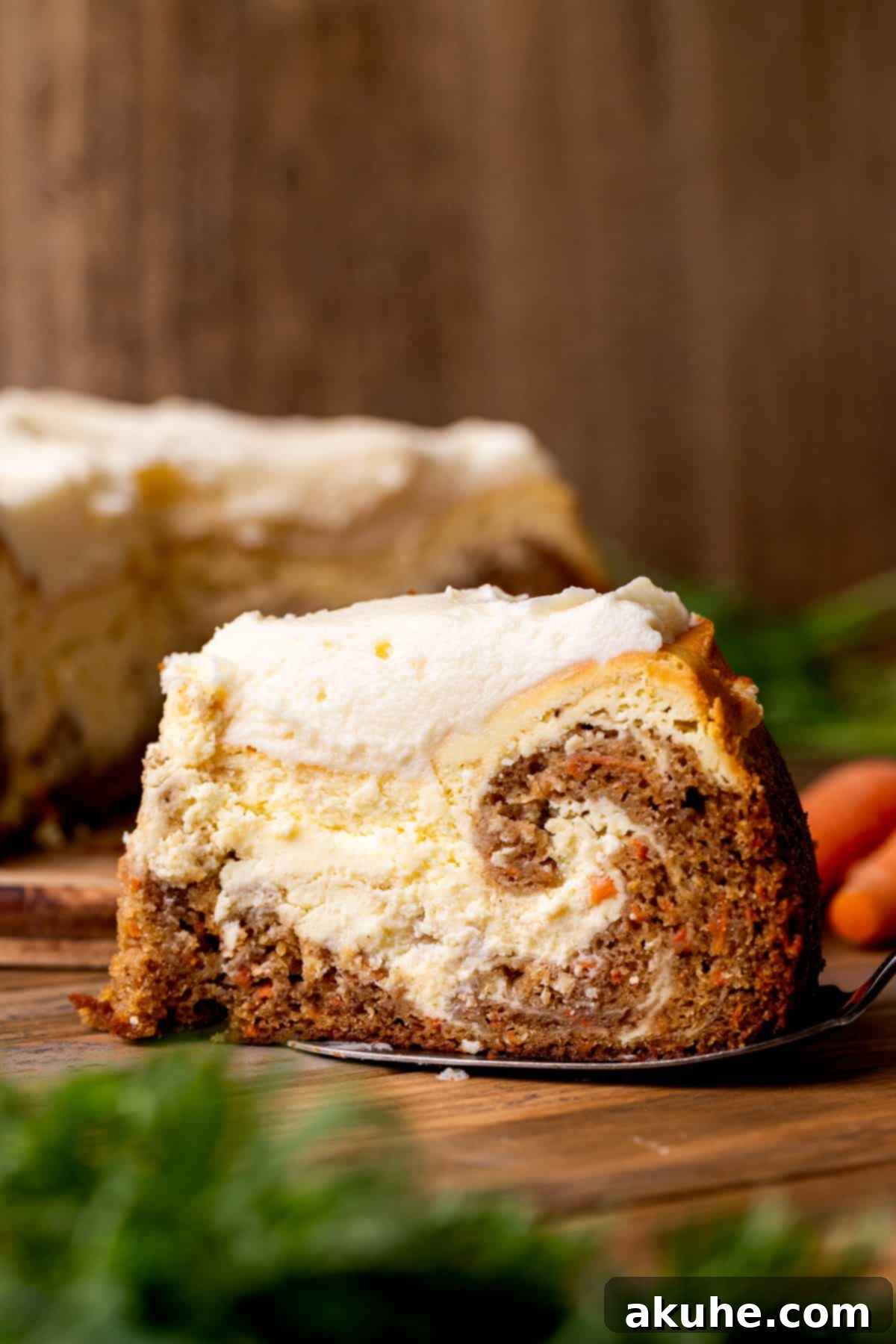
Essential Ingredient Notes for Your Carrot Cake Cheesecake
Success in baking often hinges on the quality and preparation of your ingredients. Here are some crucial notes to ensure your carrot cake cheesecake turns out perfectly. For a complete list with precise measurements, please refer to the detailed recipe card below.
- Sour Cream: This ingredient is vital for adding moisture and a slight tang to both the cheesecake and carrot cake batters. Always ensure it’s at room temperature before mixing. Room temperature sour cream incorporates more smoothly into batters, preventing lumps and ensuring a uniform consistency, which is especially important for the silky texture of the cheesecake. Plan to take it out of the fridge at least 2 hours before you begin baking.
- Eggs: Large eggs are specified for this recipe, and like the sour cream, they should be at room temperature. Cold eggs can cause your batter to curdle or seize, affecting the final texture of both the cake and cheesecake. Room temperature eggs emulsify better with other ingredients, resulting in a lighter, more even bake. Remove them from the refrigerator at least 2 hours prior to use.
- Heavy Cream: This rich dairy product contributes to the luxurious creaminess of the cheesecake batter. Again, room temperature is key. Cold heavy cream can make the batter dense and difficult to mix smoothly. Allow it to warm up for about 2 hours before incorporating.
- Powdered Sugar (for Frosting): Also known as icing sugar, this finely milled sugar is essential for a smooth, lump-free cream cheese frosting. Sifting the powdered sugar thoroughly before adding it to the frosting mixture is a non-negotiable step to prevent a gritty texture. Don’t skip this!
- Cream Cheese: The star of your cheesecake and frosting! For both components, full-fat cream cheese is highly recommended for the best flavor and texture. It must be completely softened to room temperature. This is perhaps the most critical room-temperature ingredient, as cold cream cheese will lead to a lumpy batter and a less-than-silky cheesecake. Unwrap and let it sit at room temperature for at least 2 hours, or even longer if your kitchen is cool.
- Brown Sugar: This recipe calls for brown sugar, which adds depth and a lovely caramel note to the carrot cake. Dark brown sugar provides a richer molasses flavor, but light brown sugar works beautifully too for a slightly milder taste. Always make sure it’s firmly packed when measuring to ensure accuracy.
- Carrots: The true essence of your carrot cake! For the best results, use freshly grated carrots. Pre-shredded carrots found in bags are often drier, thicker, and can result in a chewier, less desirable texture in your cake. They also tend to dry out further if grated too far in advance. Grate them finely using the smallest setting on your grater just before you plan to mix the batter for optimal moisture and tenderness.
Thoughtful Ingredient Substitutions
While sticking to the original recipe offers the best results, we understand the need for flexibility. Here are some potential substitutions to consider:
- Dairy-Free Alternatives: For those with dairy sensitivities or following a dairy-free diet, you can absolutely adapt this recipe. Utilize your favorite high-quality dairy-free cream cheese, sour cream, and heavy cream alternatives. Be aware that the texture might vary slightly, but many excellent plant-based options are available today that yield delicious results.
- Gluten-Free Flour: I have not personally tested this recipe with gluten-free flour blends. However, many readers have success with a 1:1 gluten-free all-purpose flour blend (one that includes xanthan gum) in cake recipes. If you attempt this, please let me know your results! Adjustments to liquid might be necessary, as gluten-free flours can absorb liquids differently.
- Spice Blend Adjustments: Feel free to customize the spice levels in your carrot cake. If you prefer a stronger ginger kick, slightly increase the amount. For a milder flavor, you can reduce the cinnamon or nutmeg.
- Sour Cream vs. Greek Yogurt: In a pinch, plain, full-fat Greek yogurt at room temperature can be used as a substitute for sour cream in both the cheesecake and carrot cake batters. It will provide a similar tang and moisture, though Greek yogurt can be slightly thicker.
Step-by-Step Instructions: Crafting the Silky Cheesecake Layer
Creating the perfect cheesecake batter is the first crucial step towards your magnificent carrot cake cheesecake. Follow these instructions carefully to achieve a smooth, creamy, and irresistible cheesecake layer.
STEP 1: Prepare Your Workspace and Pan. Begin by preheating your oven to 350°F (175°C). While the oven comes to temperature, prepare your 9-inch springform pan. This is a vital step for easy removal later. First, generously spray the inside of the pan with baking spray, ensuring all surfaces are covered. Next, line the bottom of the pan with a 9-inch parchment paper circle. This acts as an additional non-stick barrier. Spray the parchment paper again for extra protection. This meticulous preparation prevents sticking and ensures your cheesecake comes out clean.
STEP 2: Cream Together Cream Cheese and Sugar. In a large mixing bowl, combine the softened, room-temperature cream cheese with the white granulated sugar. Using an electric mixer (stand mixer with paddle attachment or a hand mixer) on high speed, beat these ingredients together for a full 2 minutes. The mixture should become light, fluffy, and completely smooth. During this process, be diligent about stopping the mixer frequently to scrape down the sides and bottom of the bowl with a rubber spatula. This ensures all ingredients are thoroughly incorporated, leaving no unmixed pockets of cream cheese or sugar.
STEP 3: Incorporate Wet Ingredients for Creaminess. Reduce the mixer speed to medium. Add the room-temperature sour cream, heavy cream, and pure vanilla extract to the cream cheese mixture. Continue mixing until these ingredients are fully combined and the batter is smooth and homogeneous. This step adds essential moisture and enhances the rich, creamy texture of your cheesecake.
STEP 4: Gently Fold in the Eggs. Finally, add the room-temperature large eggs to the cheesecake batter. Switch your mixer to the lowest speed setting and mix just until the eggs are combined. Overmixing the eggs can incorporate too much air, which can lead to cracks in your baked cheesecake. The goal is simply to blend them in, ensuring a smooth, cohesive batter without unnecessary aeration.
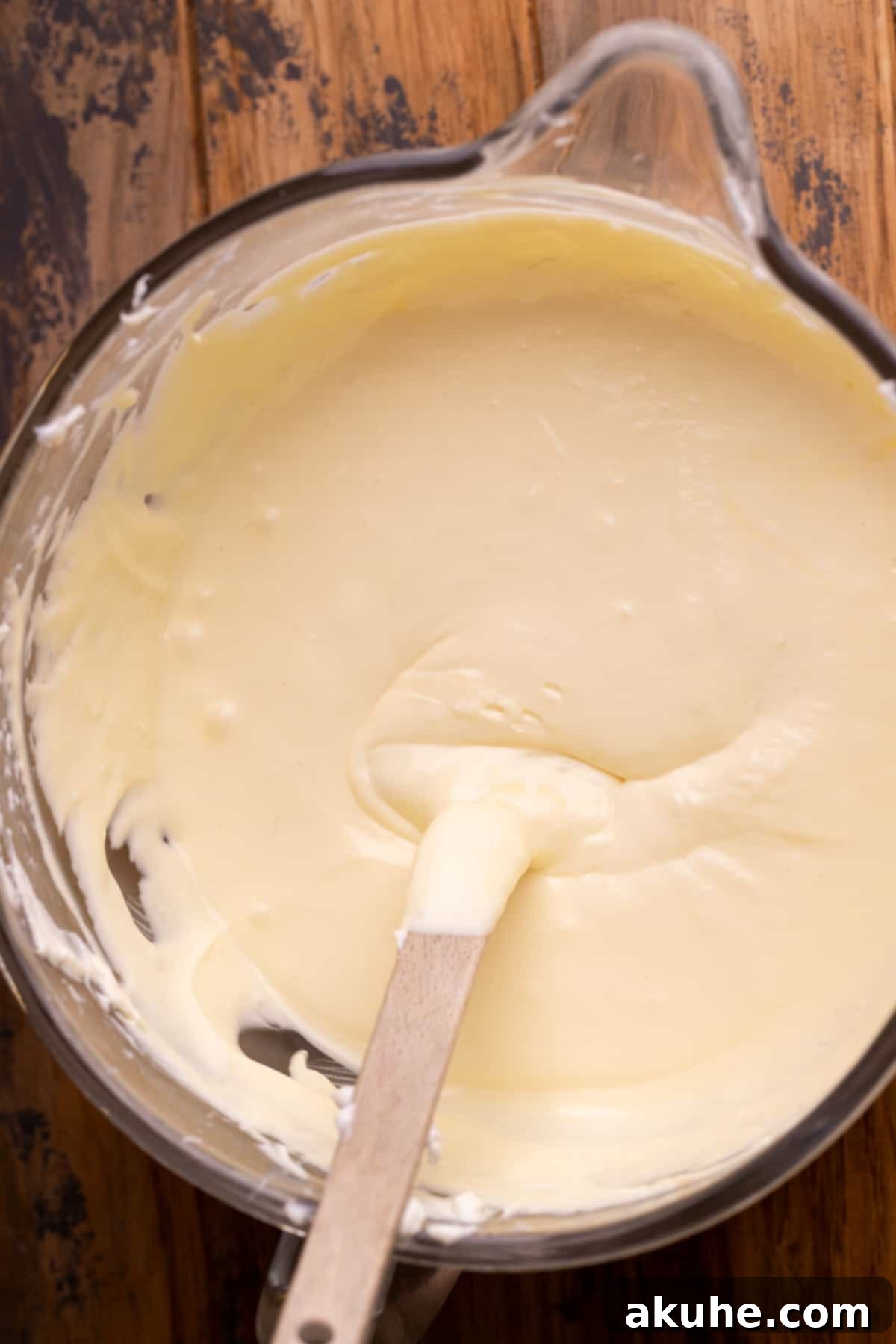
Step-by-Step Instructions: Preparing the Spiced Carrot Cake and Assembling Your Dessert
Now that your cheesecake batter is ready, it’s time to prepare the flavorful carrot cake component and assemble your unique layered dessert. This section guides you through making the carrot cake batter and layering it with the cheesecake for that beautiful marbled effect.
STEP 1: Prepare Dry Ingredients and Carrots. In a medium-sized mixing bowl, sift together the all-purpose flour, baking powder, baking soda, salt, ground cinnamon, ground nutmeg, and ground ginger. Sifting ensures there are no lumps and helps distribute the leavening agents and spices evenly. Set this dry mixture aside. Next, take your fresh carrots and grate them using the finest setting on your grater. Aim for about 1 cup of finely grated carrots. Set these aside; using freshly grated carrots is crucial for the best flavor and texture in your cake.
STEP 2: Combine Oil and Sugars. In a separate large mixing bowl, using your electric mixer on high speed, beat the oil (canola or vegetable oil works well), packed brown sugar, and white granulated sugar for 1 minute. The mixture should be well combined and slightly lighter in color. The oil contributes to the moistness of the cake, while the combination of sugars adds complex sweetness.
STEP 3: Incorporate Wet Ingredients and Dry Mix. To the oil and sugar mixture, add the room-temperature sour cream, pure vanilla extract, the finely grated carrots, and the room-temperature large eggs. Mix these ingredients on medium speed until they are just combined. Avoid overmixing. Then, gradually add the reserved dry ingredients to the wet mixture. Mix on low speed, again, only until just combined. Overmixing at this stage can develop gluten, leading to a tough cake. A few streaks of flour are acceptable, as they will disappear during baking.
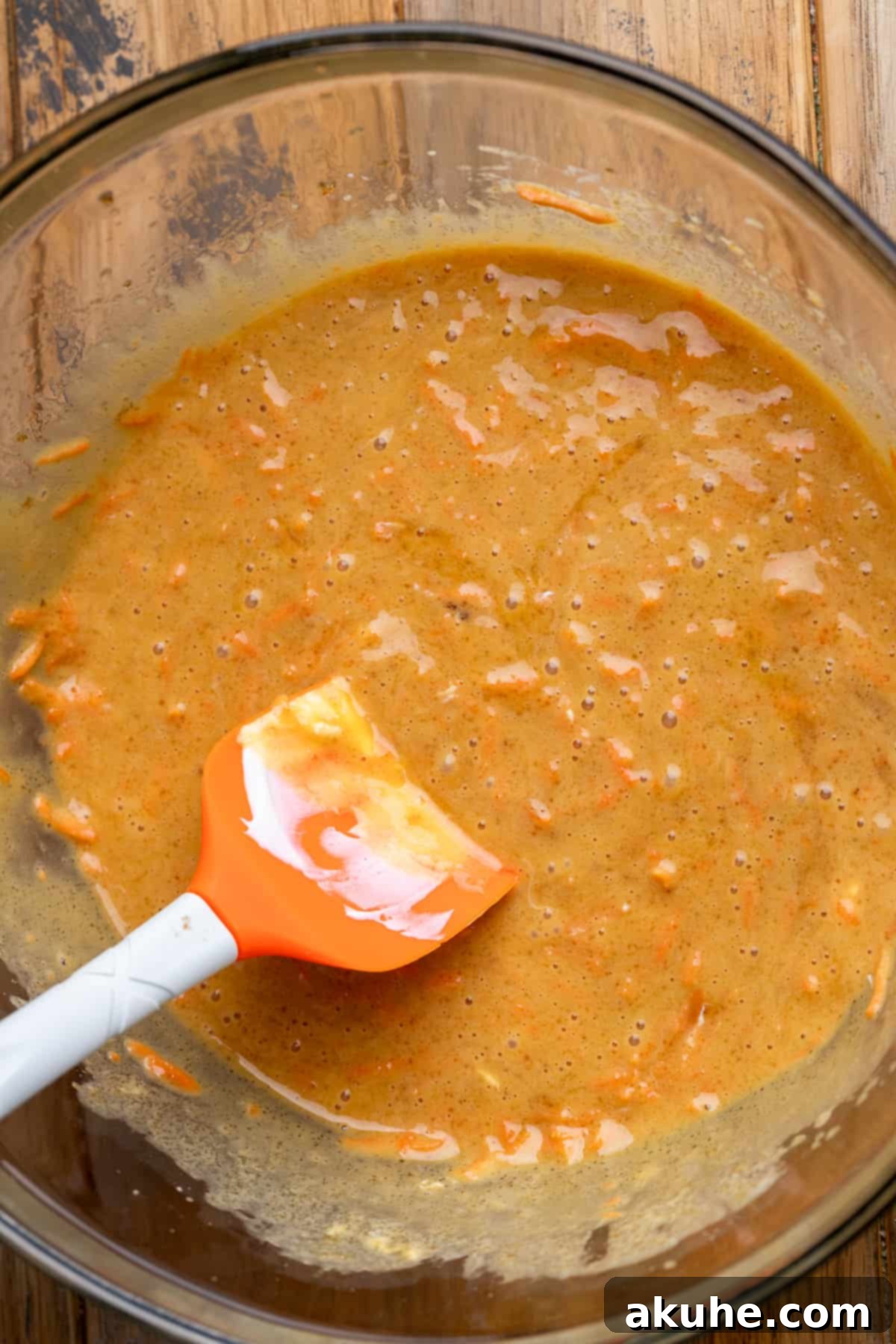
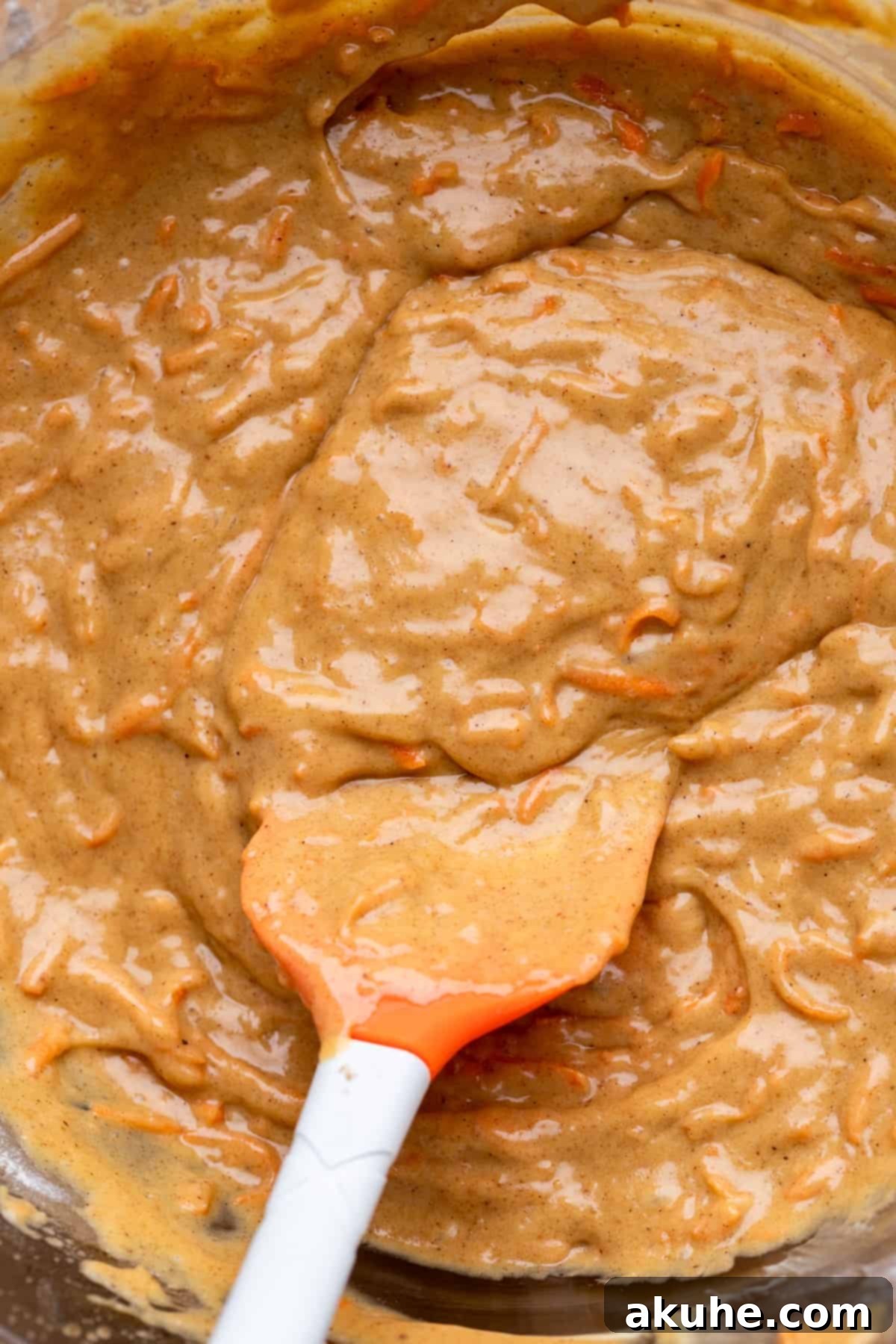
STEP 4: Begin Layering the Batters. With both batters prepared, it’s time for assembly. Pour approximately half of the carrot cake batter into the bottom of your prepared 9-inch springform pan. Using an offset spatula or the back of a spoon, gently spread this batter into an even layer, reaching the edges of the pan. Next, take about one-third of the cheesecake batter and carefully spoon it on top of the carrot cake layer. Place small dollops of cheesecake batter evenly over the carrot cake layer, rather than pouring it all at once.
STEP 5: Create the Marbled Effect with Alternating Layers. Continue the layering process to build the signature marbled design. Spoon half of the remaining carrot cake batter (this will be approximately one-quarter of the original total carrot cake batch) in dollops over the cheesecake layer. Again, do not spread it completely smooth. Repeat this with another one-third portion of the cheesecake batter, placing dollops on top of the carrot cake. Finish by adding the very last of the carrot cake batter, followed by the remaining cheesecake batter. The key to achieving beautiful marbled layers is to place dollops of each batter and resist the urge to swirl or mix them. The uneven layering will naturally bake into stunning, distinct marble patterns.
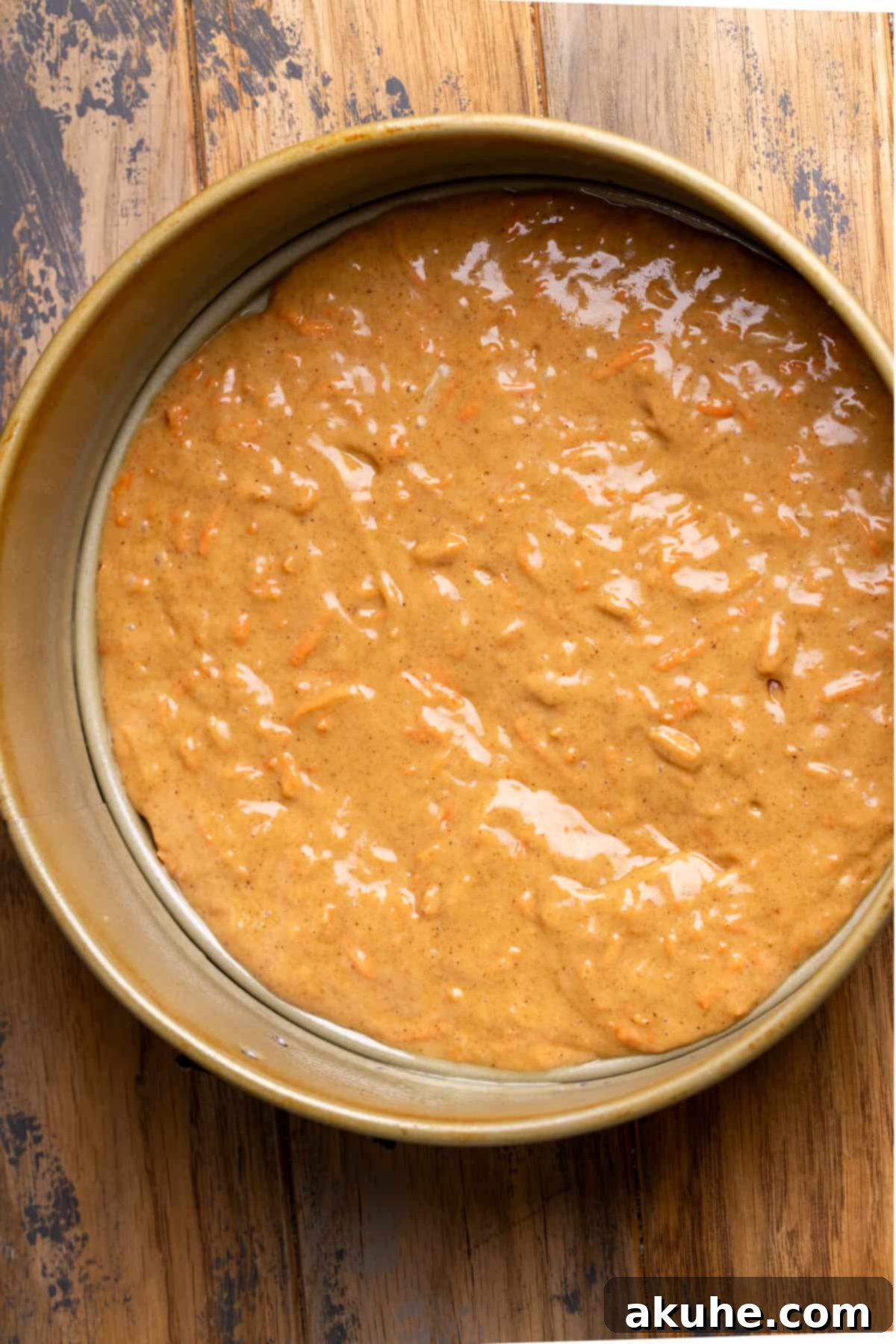
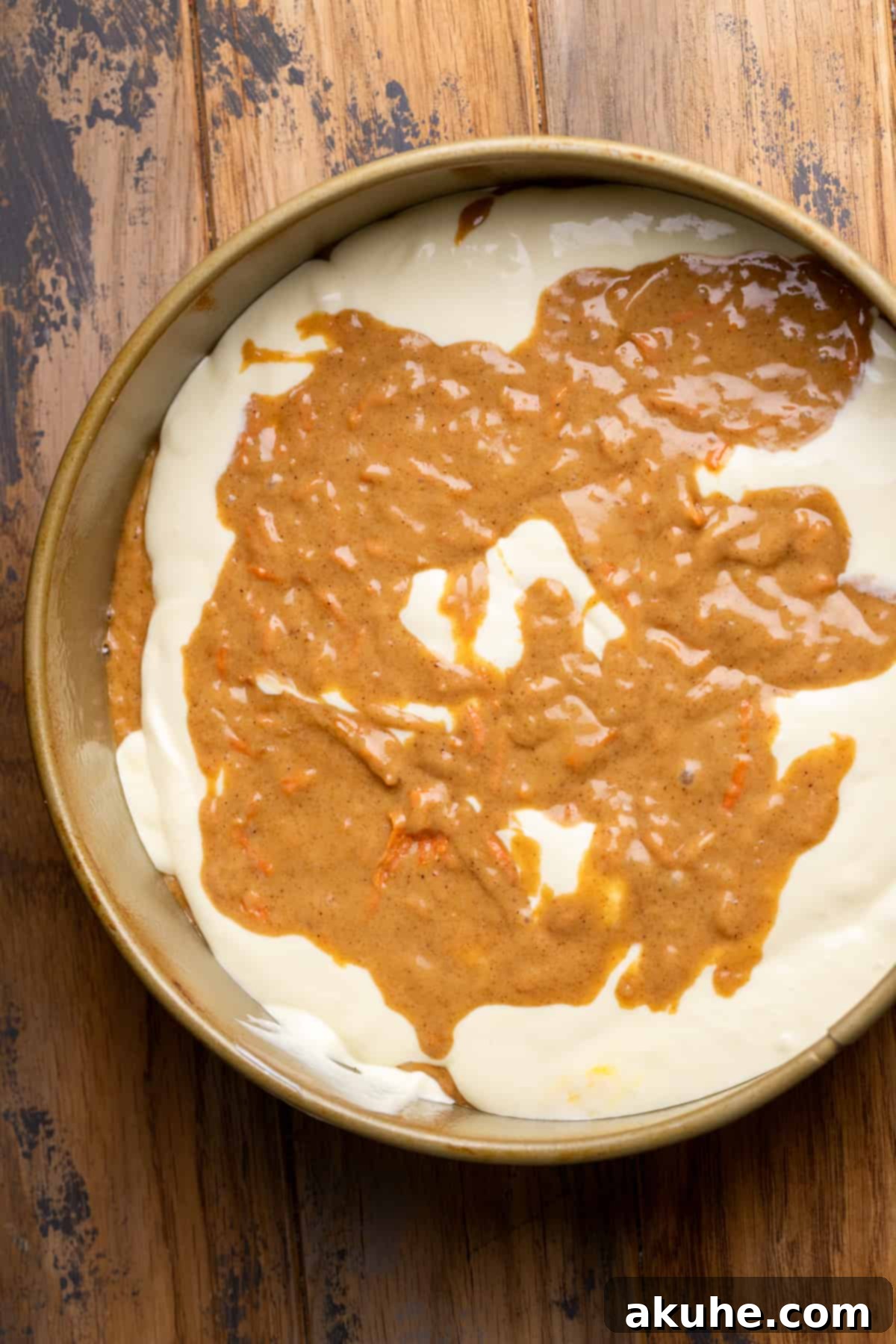
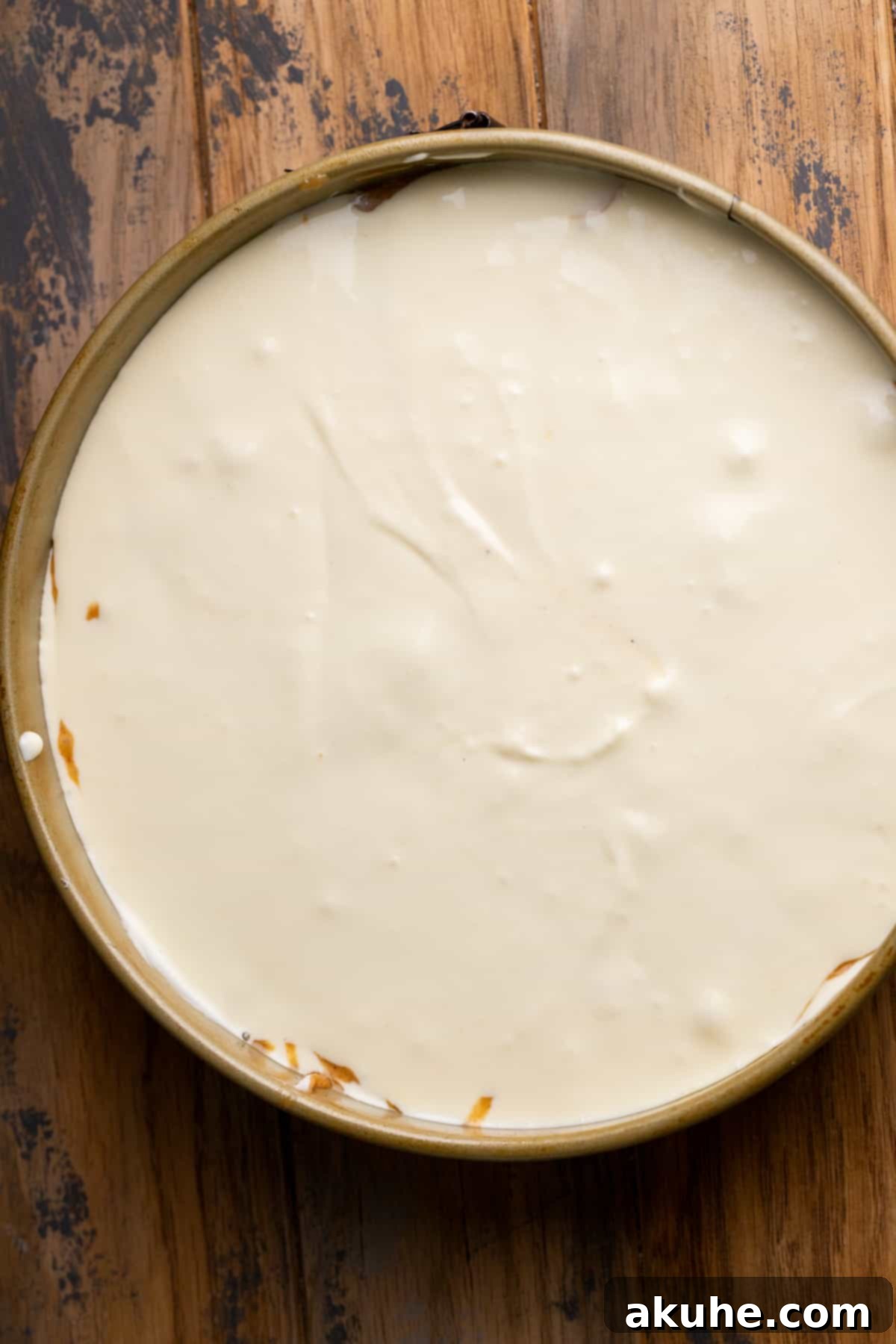
STEP 6: Bake the Layered Cheesecake. Carefully place the springform pan into your preheated oven. Bake for approximately 45-55 minutes. Baking time can vary, so it’s important to monitor its progress closely. The cheesecake is done when the edges are set, and the very center has a slight, gentle jiggle when the pan is lightly tapped. It’s crucial not to overbake, as this can dry out the carrot cake layers and cause the cheesecake to crack. A small jiggle indicates perfect doneness, as it will continue to set as it cools.
STEP 7: Cool and Chill Thoroughly. Once baked, carefully remove the carrot cake cheesecake from the oven. Place the entire springform pan on a wire cooling rack and allow it to cool completely to room temperature. This can take several hours. Once cooled, cover the pan tightly with aluminum foil to prevent it from absorbing refrigerator odors and moisture. Transfer the covered cheesecake to the refrigerator and chill it overnight, or for a minimum of 6 hours. Proper chilling is absolutely essential for the cheesecake to fully set, allowing for clean slices and optimal flavor. Patience is key!
Step-by-Step Instructions: Crafting the Perfect Cream Cheese Frosting
No carrot cake cheesecake would be complete without a generous topping of rich, tangy cream cheese frosting. This simple yet crucial component brings all the flavors together. Here’s how to create a perfectly smooth and delicious frosting to crown your masterpiece.
STEP 1: Sift the Powdered Sugar. Before you begin mixing, ensure your powdered sugar is free of lumps. Place a fine-mesh sieve over a medium-sized bowl and sift the entire amount of powdered sugar. This step is non-negotiable for achieving a silky-smooth frosting texture. Set the sifted sugar aside for later.
STEP 2: Cream Butter and Cream Cheese. In a large mixing bowl, combine the softened, room-temperature unsalted butter and the softened, room-temperature cream cheese. Using an electric mixer on high speed, beat these two ingredients together for at least 2 minutes. The mixture should become light, fluffy, and completely smooth. Throughout this process, frequently scrape down the sides and bottom of the bowl with a rubber spatula. This ensures all the butter and cream cheese are thoroughly incorporated, preventing any unmixed chunks. If you still notice small lumps after 2 minutes, continue beating for another minute until perfectly smooth.
STEP 3: Combine with Powdered Sugar and Vanilla. Reduce the mixer speed to low. Gradually add the sifted powdered sugar to the butter and cream cheese mixture, a little at a time, mixing until just combined. Once all the powdered sugar is incorporated, add the pure vanilla extract. Increase the mixer speed to high and beat the frosting for another 1-2 minutes until it becomes light, airy, and wonderfully creamy. Be careful not to overbeat, as this can make the frosting too thin.
STEP 4: Decorate Your Carrot Cake Cheesecake. Once your cheesecake is thoroughly chilled (after at least 6 hours or overnight in the fridge), carefully remove it from the springform pan. Run a thin knife around the edge of the pan before releasing the spring mechanism. Gently slide an offset spatula under the parchment paper to release the cheesecake from the base of the pan. Place the cheesecake on your serving platter. Using an offset spatula or a butter knife, generously spread the prepared cream cheese frosting evenly over the top of the chilled carrot cake cheesecake. You can create decorative swirls or keep it perfectly smooth. Your stunning dessert is now ready to be served and enjoyed!
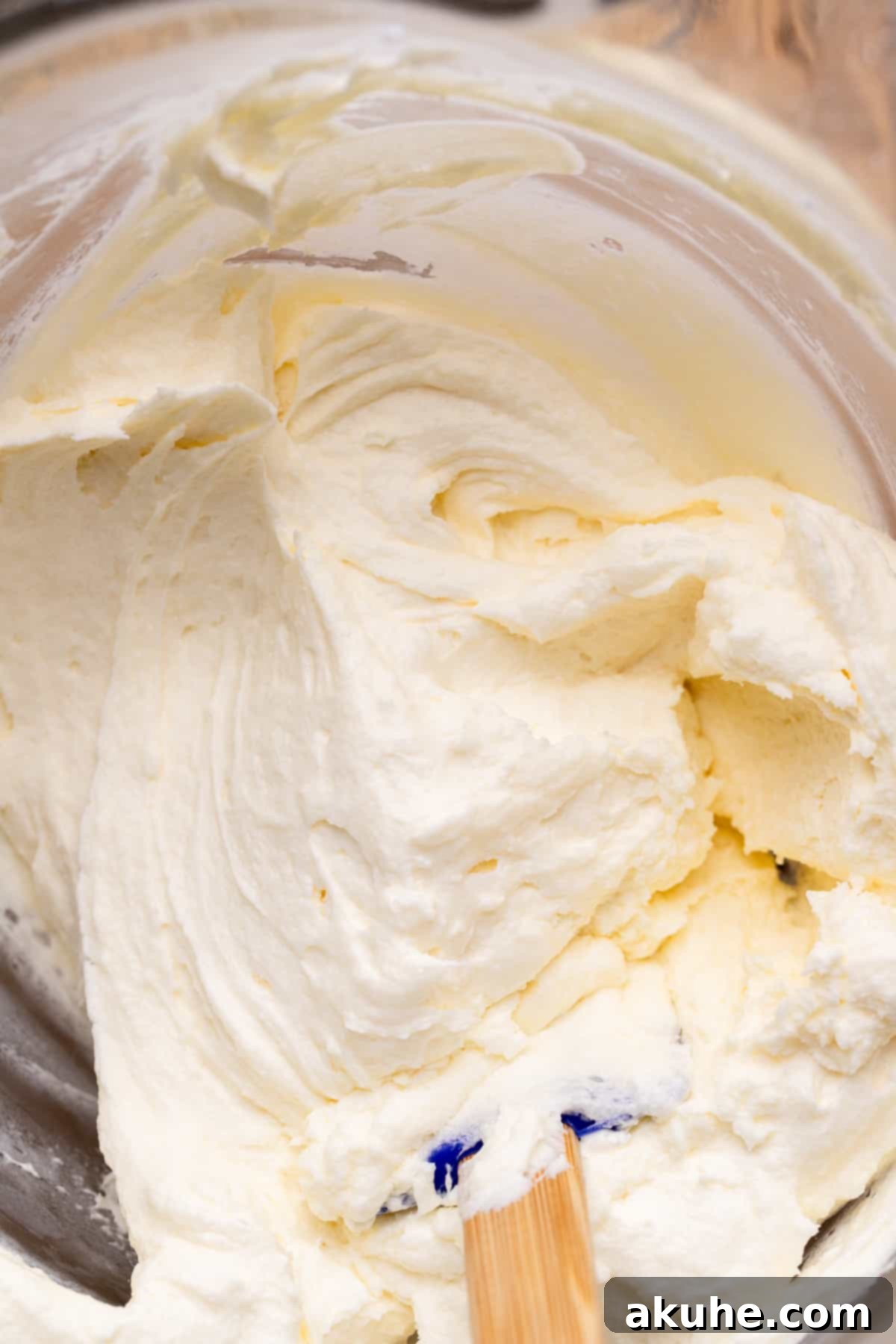
Expert Baking Tips for a Flawless Carrot Cake Cheesecake
Achieving a bakery-quality carrot cake cheesecake is entirely within reach with these expert tips:
- Precision in Flour Measurement: Incorrect flour measurement is a common culprit for dry cakes. Always use the “spoon and level” method: gently spoon flour into your measuring cup until it overflows, then level it off with the back of a knife. Never scoop flour directly from the bag with your measuring cup, as this compacts it, leading to significantly more flour than needed and a dense, dry cake. For ultimate accuracy, consider using a kitchen scale to measure flour by weight (usually around 120-125g per cup).
- Effortless Cake Removal from Springform Pan: To guarantee your beautiful cheesecake comes out of the pan without tearing or sticking, thorough preparation is essential. Start by generously spraying the entire inside of the springform pan with a high-quality nonstick baking spray (preferably one with flour in it). Next, carefully line the bottom of the pan with a parchment paper circle. Press it down smoothly. Then, spray the parchment paper circle again. Be incredibly thorough and ensure every inch is coated with spray. Any missed spots can cause the cake to stick and tear upon removal, ruining your presentation.
- No Water Bath Needed, But Watch Carefully: Unlike many traditional cheesecakes that require a water bath for even baking and to prevent cracks, this carrot cake cheesecake, with its thinner cheesecake layers interspersed with cake, typically doesn’t need one. This simplifies the baking process! However, it also means you must be extra vigilant during the final stages of baking. The carrot cake layers tend to bake faster than the cheesecake. Remove the cake from the oven as soon as the outer edges of the cheesecake appear set and only the very center has a slight, gentle jiggle when the pan is nudged. Overbaking will dry out the cake and can still lead to cracks in the cheesecake portion.
- All Ingredients at Room Temperature: As repeatedly emphasized in the ingredient notes, ensuring all dairy products and eggs are at room temperature is paramount. This allows them to emulsify properly, creating smooth batters for both components and a creamy, cohesive texture in the final product. Cold ingredients will lead to a lumpy batter and a less desirable outcome.
- Avoid Overmixing the Batters: Whether it’s the cheesecake batter (after eggs are added) or the carrot cake batter (after dry ingredients are added), overmixing can lead to a tough and dense texture. Mix just until combined for each step to keep your cake tender and your cheesecake silky.
- Chill Time is Non-Negotiable: The prolonged chilling period (6 hours or, ideally, overnight) is crucial for the cheesecake to fully set and firm up. Attempting to slice the cheesecake before it’s properly chilled will result in a messy, unset dessert. Patience here is rewarded with perfect, clean slices.
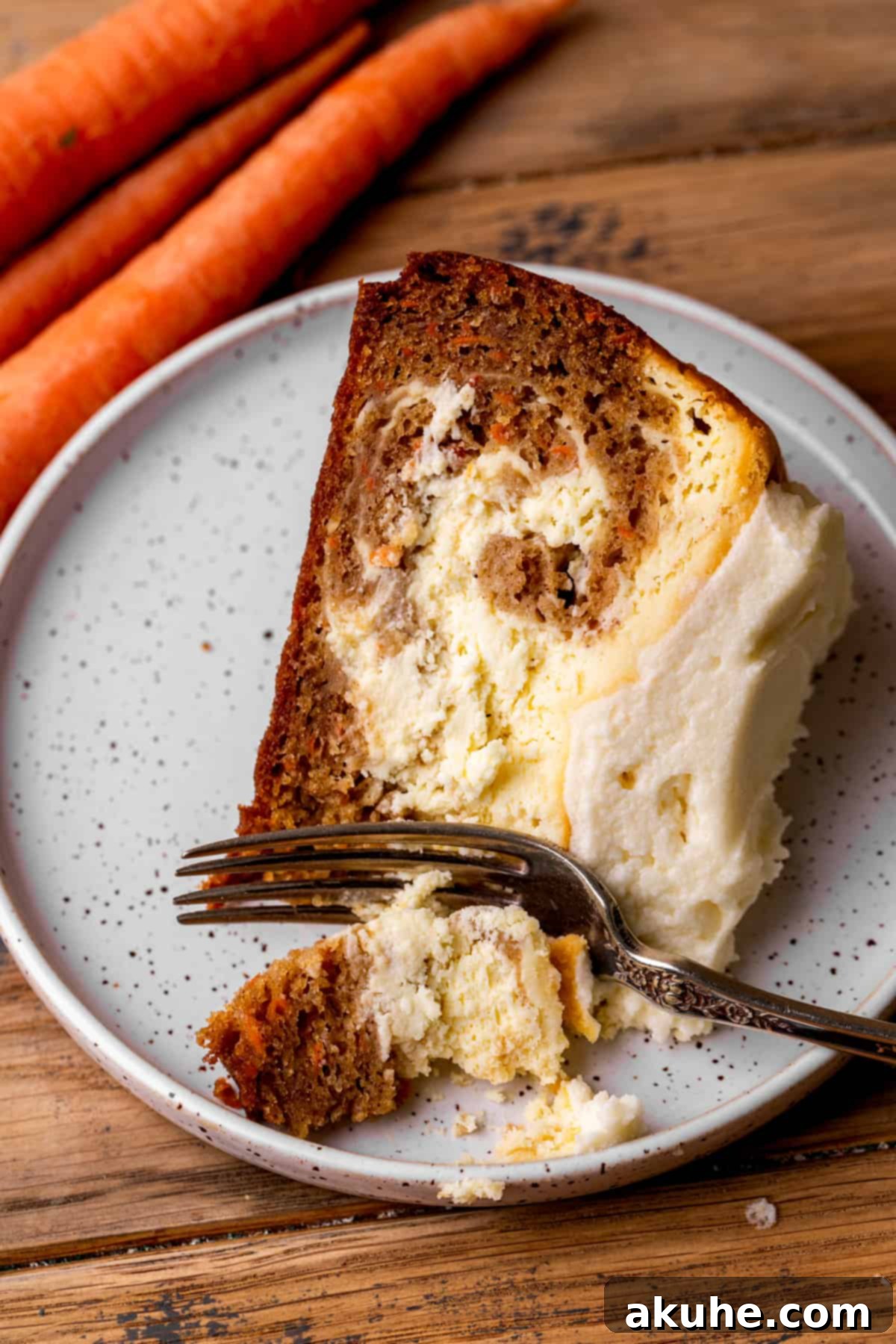
Frequently Asked Questions (FAQ)
Here are answers to some common questions about making and enjoying this carrot cake cheesecake:
It is highly recommended to stick with the specified 9-inch springform pan for this recipe. Using a smaller pan would result in too much batter for the volume, leading to an overflowing pan and uneven baking. If you only have a larger pan (e.g., 10-inch), the layers would be thinner, and baking time would need to be adjusted (likely shorter), but it might not achieve the desired height and distinct layers. A 9-inch pan provides the ideal balance for the quantity of batter.
Achieving pristine slices requires two key things: temperature and technique. First and foremost, ensure the cheesecake is very, very cold. Chilling it overnight is ideal. Next, use a sharp, thin-bladed knife. For the cleanest cuts, dip your knife in hot water and wipe it clean after each slice. This warms the blade slightly, allowing it to glide through the dense cheesecake and moist cake layers without dragging or smearing, resulting in beautifully defined slices every time.
The secret to distinct, marbled layers lies in your layering technique. When adding the cheesecake and carrot cake batters, place them in dollops rather than pouring large, flat layers. The uneven placement of these dollops is what creates the beautiful, swirling, marbled pattern as the cake bakes. Resist the urge to swirl or mix the batters together once they are in the pan. Swirling them aggressively will blend them too much, leading to muddy colors and less defined lines. Let the baking process do its magic with the dolloped layers.
Absolutely! This cheesecake is an excellent make-ahead dessert. In fact, making it a day in advance allows for proper chilling and enhances the flavors. You can bake and chill the cheesecake (before frosting) up to 2-3 days in advance. Store it covered tightly in the refrigerator. Apply the cream cheese frosting closer to serving time for the freshest taste and appearance, or frost it a day before and keep it chilled.
Exciting Recipe Variations to Explore
Once you’ve mastered the classic carrot cake cheesecake, don’t hesitate to get creative with these delicious variations:
- Charming Carrot Decorations: For an extra touch of whimsy and elegance, set aside a small portion of your cream cheese frosting before spreading it on the cheesecake. Dye this reserved frosting with orange food coloring, and a tiny bit with green food coloring. Using a piping bag with a small round tip, pipe miniature carrots (orange body, green leafy tops) onto the top of your cheesecake. This adds a delightful visual element, especially for Easter or spring celebrations.
- Indulgent Chocolate Carrot Cheesecake: Elevate your dessert by introducing chocolate! You can easily adapt this recipe to include a decadent chocolate cheesecake layer. Simply use this chocolate cheesecake recipe for the cheesecake batter portion of the recipe. The rich chocolate will beautifully complement the spiced carrot cake, creating an even more luxurious and irresistible treat.
- Nutty or Fruity Add-ins: For an enhanced texture and flavor, consider folding in 1/2 to 1 cup of chopped pecans or walnuts into your carrot cake batter. If you enjoy a touch of fruitiness, you could also gently fold in 1/2 cup of golden raisins or dried cranberries. Be mindful not to add too many, as they can weigh down the batter.
- Spiced Crumble Topping: Instead of traditional cream cheese frosting, you could opt for a streusel or crumble topping. Combine flour, brown sugar, cold butter, and a pinch of cinnamon. Sprinkle this mixture over the top of the cake before baking for a delightful crunchy crust.
Special Tools for Baking Success
While many kitchen tools are versatile, some specific items can greatly simplify the process and improve the outcome of your carrot cake cheesecake:
- High-Quality Springform Pan: A good quality 9-inch springform pan is absolutely essential for cheesecakes. Its removable sides allow for easy release without damaging the delicate structure of the cake. If you prefer a taller, more dramatic cheesecake, an 8-inch springform pan can be used, though you might need to slightly increase the baking time.
- Convenient Parchment Paper Circles: While you can cut parchment paper to size, pre-cut 8-inch parchment paper circles are a true time-saver for lining the bottom of your springform pan. They ensure a perfect fit and prevent any sticking, making removal a breeze.
- Nonstick Baking Spray with Flour: A reliable nonstick spray that contains flour is a baker’s best friend. It provides an extra layer of protection against sticking, especially important for the sides of the springform pan where cheesecake can sometimes adhere stubbornly.
- Versatile Offset Spatula: An offset spatula is invaluable for spreading batters smoothly and evenly in the pan, as well as for applying frosting. Its angled blade keeps your knuckles clear of the cake, allowing for precise and effortless spreading of creamy layers and frosting.
- Electric Mixer: Whether a stand mixer with a paddle attachment or a powerful hand mixer, an electric mixer is crucial for properly creaming the butter and cream cheese, as well as achieving the right consistency for both batters and the frosting.
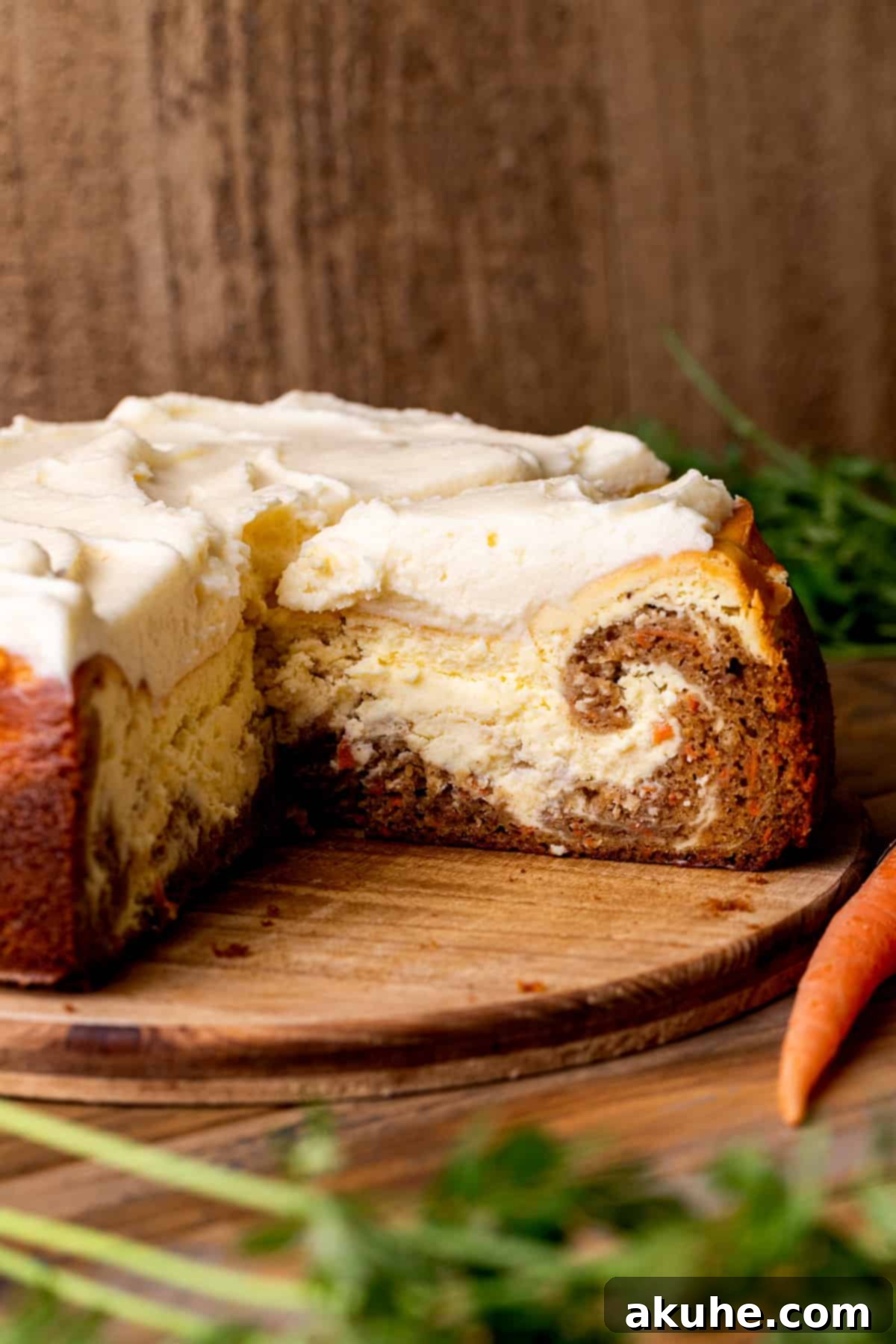
Storing and Freezing Your Carrot Cake Cheesecake
Proper storage is essential to maintain the freshness, flavor, and texture of your delicious carrot cake cheesecake. Here’s how to store it and even how to freeze it for future enjoyment:
Refrigerator Storage: After decorating, your carrot cake cheesecake should always be stored in the refrigerator. Place it in an airtight container, such as a cake carrier, to protect it from drying out and absorbing other food odors. Stored correctly, the cheesecake will remain fresh and delicious for up to 5 days. For optimal taste and texture, allow slices to come to room temperature for about 15-20 minutes before serving, as this enhances the creaminess of the cheesecake and the aroma of the spices.
Freezing Individual Slices: This cheesecake freezes beautifully, making it perfect for portion control or saving for later cravings. To freeze individual slices, first ensure the cheesecake is fully chilled and then cut it into your desired portions. Wrap each slice tightly in plastic wrap, then an additional layer of aluminum foil. Place the wrapped slices in an airtight freezer-safe container to prevent freezer burn. They can be stored in the freezer for up to 30 days. To enjoy, thaw individual slices in the refrigerator overnight, or on the countertop for 1-2 hours until softened to your liking.
Freezing the Undecorated Cheesecake: If you’re planning to make the cheesecake well in advance or want to save it for a later date, you can freeze the entire undecorated cheesecake. Once the cheesecake has baked and chilled overnight in the refrigerator (this initial chill is crucial for stability), remove it from the springform pan. Wrap the entire cheesecake tightly in several layers of plastic wrap, followed by a layer of aluminum foil. This double-layer protection helps prevent freezer burn. It can be frozen for up to 30 days. When you’re ready to serve, thaw the cheesecake in the refrigerator overnight. Allow it to sit at room temperature for 1-2 hours before decorating with the cream cheese frosting and serving.
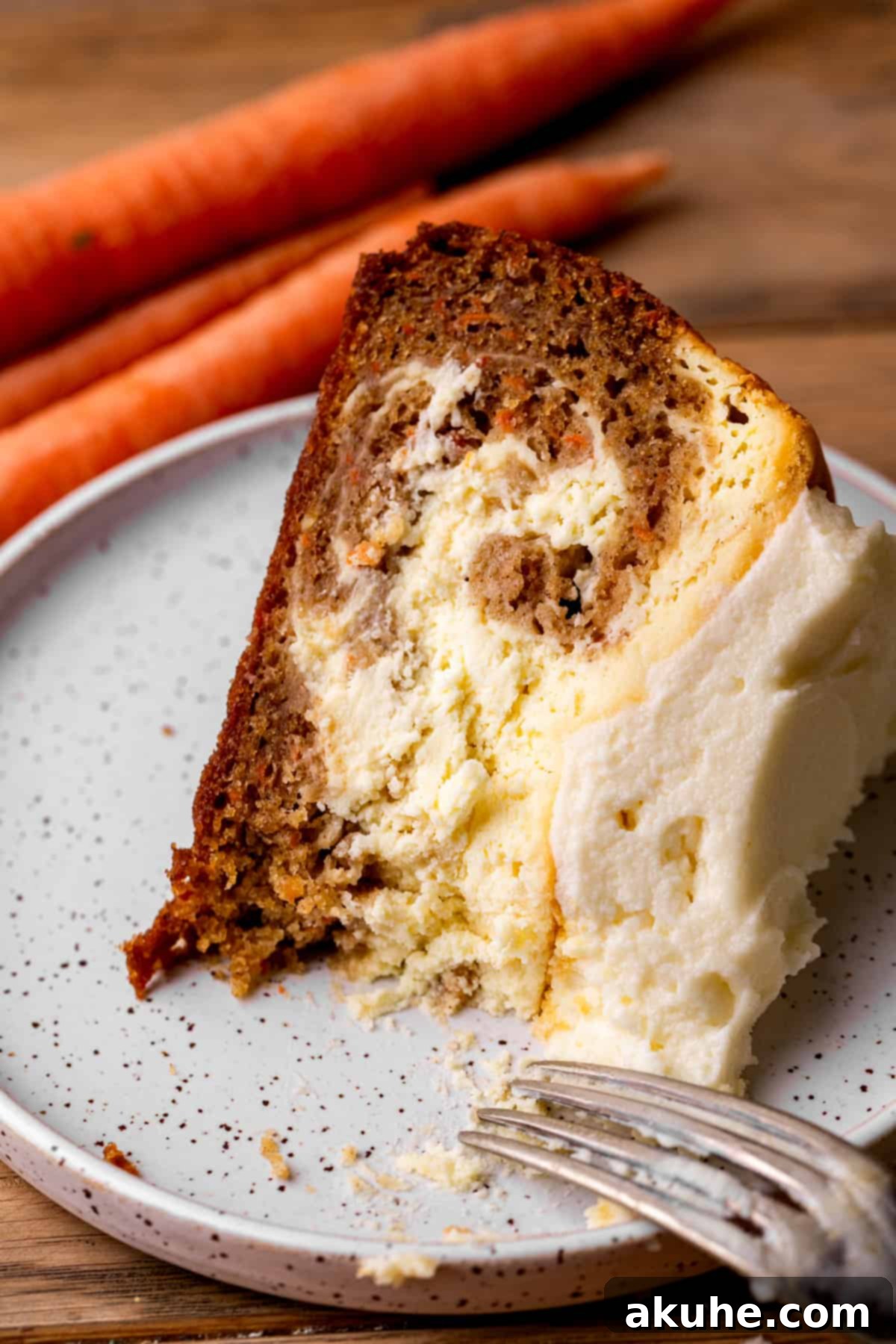
Other Delicious Carrot Cake Recipes to Explore
If you love the flavor profile of carrot cake, be sure to check out these other fantastic recipes that celebrate this classic dessert in various forms. Expand your baking horizons beyond this cheesecake hybrid!
Whether you’re celebrating spring, or just looking for bright, fresh flavors, these recipes are perfect additions to your baking list:
- Lemon Drizzle Cake: A zesty and moist cake with a delightful citrus glaze.
- Lemon Raspberry Rolls: Soft, sweet rolls bursting with tart lemon and juicy raspberries.
- Strawberry Brownies: A fruity twist on classic fudgy brownies.
- Lemon Crinkle Cookies: Chewy, tangy cookies with a beautiful crackled finish.
- Strawberry Vanilla Cake: A light and airy cake with fresh strawberries and vanilla notes.
Did you fall in love with this recipe? We would be thrilled if you could leave a STAR REVIEW below! Your feedback helps us grow and inspires other bakers. Don’t forget to tag me on Instagram @stephaniesweettreats with your creations. For more delectable ideas and baking inspiration, make sure to follow me on Pinterest. Happy baking!
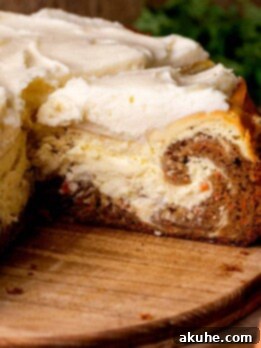
Rating: 5 out of 5 stars (based on 8 reviews)
Carrot Cake Cheesecake
By Stephanie Rutherford
This carrot cake cheesecake combines the best of carrot cake and classic cheesecake! It features beautiful swirls of spiced carrot cake and creamy cheesecake, all topped with a luscious cream cheese frosting.
Print Recipe |
Pin Recipe |
Leave a Review
Prep Time: 40 mins
Cook Time: 55 mins
Chilling Time: 6 hrs
Total Time: 7 hrs 35 mins
Servings: 16 slices
Ingredients
Cheesecake Layer
- 16 oz Cream cheese, room temperature
- 1/2 cup White granulated sugar
- 1/2 cup Sour cream, room temperature or Greek yogurt
- 1/4 cup Heavy cream, room temperature
- 1 tsp Pure vanilla extract
- 2 Large eggs, room temperature
Carrot Cake Layer
- 1 3/4 cup All-purpose flour
- 1 tsp Baking powder
- 1/2 tsp Baking soda
- 1/2 tsp Salt
- 1 1/2 tsp Ground cinnamon
- 1/4 tsp Ground nutmeg
- 1/2 tsp Ground ginger
- 1/2 cup Oil, canola or vegetable oil
- 1/2 cup Brown sugar, packed (light or dark)
- 1/3 cup White granulated sugar
- 1/2 cup Sour cream, room temperature or Greek yogurt
- 1 tsp Pure vanilla extract
- 1 cup Grated carrots, about 2 large carrots, freshly grated
- 2 Large eggs, room temperature
Cream Cheese Frosting
- 3/4 cup Unsalted butter, room temperature
- 8 oz Cream cheese, room temperature
- 1 3/4 cup Powdered sugar, sifted
- 1 tsp Pure vanilla extract
Instructions
For the Cheesecake Layer:
- Preheat the oven to 350℉ (175°C). Spray a 9-inch springform pan with baking spray. Line the bottom with a 9-inch parchment paper circle and spray again.
- Using an electric mixer, beat the room-temperature cream cheese and white granulated sugar on high speed for 2 minutes, until light and fluffy. Scrape the bowl with a rubber spatula halfway through to ensure all ingredients are incorporated.
- Add the room-temperature sour cream, heavy cream, and pure vanilla extract. Mix on medium speed until the batter is smooth.
- Add the room-temperature large eggs to the cheesecake batter and mix on low speed until just combined. Set this batter aside.
For the Carrot Cake Layer:
- In a medium bowl, sift together the all-purpose flour, baking powder, baking soda, salt, ground cinnamon, ground nutmeg, and ground ginger. Set aside. Grate the fresh carrots on the smallest setting of your grater and set aside.
- Using an electric mixer, beat the oil, packed brown sugar, and white granulated sugar on high speed for 1 minute until well combined.
- Add the room-temperature sour cream, pure vanilla extract, grated carrots, and room-temperature large eggs. Mix on medium speed until combined. Gradually add the dry ingredients mixture and mix on low speed until just combined. Avoid overmixing.
- Pour about half of the carrot cake batter into the bottom of the prepared springform pan. Spread it into an even layer with an offset spatula.
- Spoon approximately one-third of the cheesecake batter in small dollops evenly over the carrot cake layer.
- Next, spoon half of the remaining carrot cake batter (about one-quarter of the total carrot cake batter) in dollops over the cheesecake layer. Repeat with another one-third portion of the cheesecake batter. Top with the very last of the carrot cake batter, followed by the remaining cheesecake batter. Remember to place dollops and do not swirl them together to achieve marbled layers.
- Bake for 45-55 minutes, or until the edges of the cheesecake are set and the very center has only a slight jiggle. It is easy to overbake, so check carefully.
- Remove the pan from the oven and place it on a wire cooling rack. Allow the cheesecake to cool completely to room temperature. Once cooled, cover the pan tightly with foil and chill in the refrigerator for at least 6 hours, or ideally overnight, for best results and clean slicing.
For the Cream Cheese Frosting:
- Sift the powdered sugar into a bowl and set it aside.
- In a large mixing bowl, beat the softened unsalted butter and softened cream cheese together on high speed for 2 minutes, until light and smooth. Scrape the bowl with a rubber spatula to ensure all ingredients are incorporated. If any chunks remain, beat for another minute.
- Add the sifted powdered sugar gradually on low speed until just combined. Then, add the pure vanilla extract and beat on high speed until the frosting is creamy and fluffy.
- Once the carrot cake cheesecake is completely chilled, carefully remove it from the springform pan and remove the parchment paper. Spread the prepared cream cheese frosting evenly over the top of the cheesecake using an offset spatula. Slice and serve!
Notes
- Flour Measurement: Always measure flour by spooning it into the measuring cup and leveling it off with a straight edge, or use a kitchen scale for precision. Compacted flour can lead to a dry cake batter.
- High Altitude Baking: If you are baking at a high altitude, consider adding an extra 1 tablespoon of all-purpose flour to the carrot cake batter.
- Room Temperature Ingredients: Remember to pull out all dairy ingredients (cream cheese, sour cream, heavy cream, butter) and eggs at least 2 hours before baking to ensure they reach room temperature. This is crucial for a smooth batter and optimal texture.
Nutrition Information (per serving)
Calories: 447 kcal, Carbohydrates: 45g, Protein: 5g, Fat: 35g, Saturated Fat: 17g, Polyunsaturated Fat: 3g, Monounsaturated Fat: 11g, Trans Fat: 0.4g, Cholesterol: 79mg, Sodium: 276mg, Potassium: 107mg, Fiber: 0.5g, Sugar: 19g, Vitamin A: 982IU, Vitamin C: 0.2mg, Calcium: 85mg, Iron: 1mg
